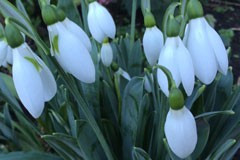- Out-of-Stock



Widely known as the "English" snowdrop, these are native to Turkey and the Caucasus, described by British botanist and plant hunter Henry John Elwes in his botanical expedition to the Caucasus in 1874. One of the more robust species, elwesii is easily recognised by its wider leaf and large flower. Best in a cool shady position on well drained but fertile soil kept slightly damp during dormancy.
Widely known as the "English" snowdrop, these are native to Turkey and the Caucasus, described by British botanist and plant hunter Henry John Elwes in his botanical expedition to the Caucasus in 1874. One of the more robust species, elwesii is easily recognised by its wider leaf and large flower. Best in a cool shady position on well drained but fertile soil kept slightly damp during dormancy.
Data sheet
A long stemmed form suitable for picking. Violet blue flowers in winter and early spring.
Classical double white border carnation, with good fragrance and vigourous growth. Long lasting plant for rock garden or border. Cut back occasionally.
Beautiful semi deciduous shrub with attractive textured multicoloured leaves and white flowers, likes good drainage and shade or dappled sun. Can often retain its leaves but benefits from an occasional light prune to promote basal growth.
Silvery succulent, ideal in dry and exposed conditions including coastal situations. Flowers are coral pink during winter and the bushy form of this variety associates well with Stipa gigantea, aeoniums, fascicularia, and sedums.
Fan iris, attractive foliage for floral work, and feathery white and lilac flowers in spring. Useful under trees and in larger spaces.
Tall, sun loving perennial for the herbaceous border and cottage garden, providing lasting structure and a long show of golden ochre flowers. Plant with heleniums, day lilies, iris and salvias.
A beautiful Allium x rosenbachianum cultivar with tall stems topped with purple spherical flowers, requires good drainage in sun and to dry off in summer
Pink Siberian iris which combines well with white colour schemes. Useful for in-fill between roses or in the mixed border.
Windflowers are lovely in shaded woodland, an easy and reliable understorey beneath trees and shrubs. This is the pale pink form.
Vigourous old fashioned mop top type, pure white flowers, useful for specimen or border plantings. Strong stemmed upright variety, useful for floral work.
Allium like plant with pink flowers and grassy foliage, tough and long lived, often used in cottage gardens and border plantings
Dwarf "Solomon"s Seal" for the woodland garden or shady rockgarden. Spreads to form a mat.
Clump forming perennial loosely resembling a diplarrhena or iris. Prefers part shade amongst other plants, ideal under roses or in a mixed border or cottage garden. White flowers in summer.
Ground covering alpine plant for rock garden or above a dry-stone wall. Rich pink flowers completely cover the entire plant so foliage is obscured, protect from excessive winter wet.
A useful pond side plant or for wet soils, where it will form a dense ground cover. Bright green leaves and red flowers during summer.
A bushy plant with many branched stems topped with dark yellow black centered cone flowers. The foliage is a dark glossy green similar in appearance to heliopsis and echinaceas. Flowers from mid-summer into autumn.

Widely known as the "English" snowdrop, these are native to Turkey and the Caucasus, described by British botanist and plant hunter Henry John Elwes in his botanical expedition to the Caucasus in 1874. One of the more robust species, elwesii is easily recognised by its wider leaf and large flower. Best in a cool shady position on well drained but fertile soil kept slightly damp during dormancy.